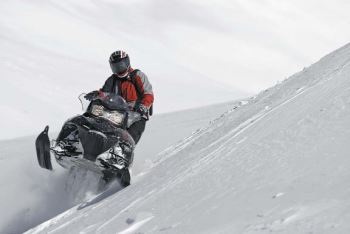 The old saying, "The more things change, the more they stay the same," certainly applies to the 700 mountain class.
The old saying, "The more things change, the more they stay the same," certainly applies to the 700 mountain class.
There are still two snowmobiles in the 700 mountain class for 2009. In fact, they're the same two snowmobiles as 2008-the Polaris 700 RMK and Yamaha Nytro MTX. A quick glance at the machines and the specs seems to indicate that few things have changed on the respective sleds.
So, there really are no surprises in the 700 mountain class for 2009.
Or are there?
Honestly, we're a bit surprised the 700 RMK is still hanging around, what with the popularity of the 800 RMKs and the 800 mountain class in general. If anything, the 700 RMK gets overlooked in the Polaris mountain lineup. It's a great `tweener sled that is flanked by the 600 and 800 RMK.
It's also a pleasant and welcome surprise at how Yamaha continues to inch closer to the high marks the other mountain machines have set. We think the Nytro MTX is closest to the mark of any of the mountain machines Yamaha has to offer. For most of the SnowTest crew, the Nytro is our favorite Yamaha to ride. There's not just one single reason it's our favorite, but rather a combination of reasons.
Apples To Apples?
 Before we dive any farther into this class we need to address one issue that some folks who read SnoWest Magazine tend to get hung up on. Why do we put the 700 RMK and the Nytro MTX in the same class? Simple. It all has to do with horsepower. The 700 RMK is rated at about 140 hp while the Nytro MTX has 130 hp. The 600s are around 118-120 hp so we think that the Nytro MTX is a better fit in the 700 class than with the 600s. We admit right up front the obvious fact that the Yamaha gives up 10 hp to the Polaris but we take that into account when we ride and compare models.
Before we dive any farther into this class we need to address one issue that some folks who read SnoWest Magazine tend to get hung up on. Why do we put the 700 RMK and the Nytro MTX in the same class? Simple. It all has to do with horsepower. The 700 RMK is rated at about 140 hp while the Nytro MTX has 130 hp. The 600s are around 118-120 hp so we think that the Nytro MTX is a better fit in the 700 class than with the 600s. We admit right up front the obvious fact that the Yamaha gives up 10 hp to the Polaris but we take that into account when we ride and compare models.
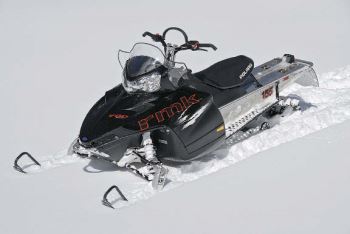 Having just made the horsepower comparisons, let's start with the powerplants on the RMK and Nytro MTX. They couldn't be any more different. The Polaris features a liquid-cooled, two-cylinder two-stroke with a displacement of 700cc and Cleanfire Injection with four injectors (two per cylinder). The Liberty engine, assembled in Wisconsin, utilizes a variable exhaust system with a single pipe. The Nytro MTX Genesis 130FI engine is a 1049cc, three-cylinder four-stroke and is liquid-cooled. Yamaha uses 41 mm Mikuni carbs in the fuel-injected powerplant. As mentioned, the Polaris has 140 hp while the Yamaha has 130 hp. One feature unique to the Yamaha Genesis engine is the Engine Braking Reduction System, which essentially (and ironically) allows the engine to act more like a two-stroke than a four-stroke, at least in the area of engine braking. When you let off the throttle on a four-stroke, you get the feeling the brake has been applied and sometimes you feel like you're going to hit the handlebars with your chest. Yamaha has countered that braking with the EBRS, which allows a small amount of air to pass through the sled's fuel injection system when the throttle is released. That allows the sled to coast, much like a two-stroke does when you let off the throttle.
Having just made the horsepower comparisons, let's start with the powerplants on the RMK and Nytro MTX. They couldn't be any more different. The Polaris features a liquid-cooled, two-cylinder two-stroke with a displacement of 700cc and Cleanfire Injection with four injectors (two per cylinder). The Liberty engine, assembled in Wisconsin, utilizes a variable exhaust system with a single pipe. The Nytro MTX Genesis 130FI engine is a 1049cc, three-cylinder four-stroke and is liquid-cooled. Yamaha uses 41 mm Mikuni carbs in the fuel-injected powerplant. As mentioned, the Polaris has 140 hp while the Yamaha has 130 hp. One feature unique to the Yamaha Genesis engine is the Engine Braking Reduction System, which essentially (and ironically) allows the engine to act more like a two-stroke than a four-stroke, at least in the area of engine braking. When you let off the throttle on a four-stroke, you get the feeling the brake has been applied and sometimes you feel like you're going to hit the handlebars with your chest. Yamaha has countered that braking with the EBRS, which allows a small amount of air to pass through the sled's fuel injection system when the throttle is released. That allows the sled to coast, much like a two-stroke does when you let off the throttle.
Yamaha also uses a single rear exiting exhaust, which, according to Yamaha engineers, maximizes horsepower by using a straight pipe and reduces the underhood heat.
If those engine descriptions sound similar to 2008 specs, they should, because neither powerplant changed from the previous year.
Power To The People
 That didn't dampen the enthusiasm the SnoWest SnowTest staff has for these two engines. Commenting on the 700 RMK, one SnowTester said, "One of my favorite engines of any mountain sled." Another said, "This is an awesome power and performance package for a 700cc motor."
That didn't dampen the enthusiasm the SnoWest SnowTest staff has for these two engines. Commenting on the 700 RMK, one SnowTester said, "One of my favorite engines of any mountain sled." Another said, "This is an awesome power and performance package for a 700cc motor."
Two traits of the 700 RMK engine that SnowTesters specifically pointed out were "useable power" and "broad powerband," both of which mirror comments made about the 700's big brother, the 800. Broad powerband indicates good power from the bottom end through the top end with no one part of the powerband really any stronger than another part. The useable part comes into play over a wide variety of conditions and simply means being about to call on the sled to do something and it responds. For example, you need to hit the throttle when you're coming out of a turn to head uphill and it's responsive and gets the job done without the rider having to otherwise compensate for a lack of power. That's what the 700 RMK does.
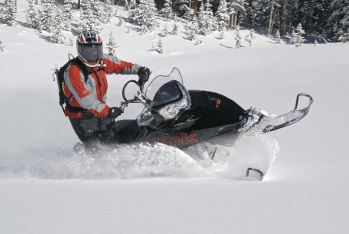 To a rider, each SnowTester had the same assessment of the Nytro MTX engine. It's a strong motor with good power but the sled's weight overshadows the ability of the engine to react in certain riding conditions. Simply put, its power-to-weight is lacking compared to the RMK. One SnoWest rider made this observation, "It has an easy throttle pull and seems to feel the best in the midrange." You just can't help wonder if this engine were in a lighter sled what the result would be. Our guess would be we would be singing its praises to the high heavens.
To a rider, each SnowTester had the same assessment of the Nytro MTX engine. It's a strong motor with good power but the sled's weight overshadows the ability of the engine to react in certain riding conditions. Simply put, its power-to-weight is lacking compared to the RMK. One SnoWest rider made this observation, "It has an easy throttle pull and seems to feel the best in the midrange." You just can't help wonder if this engine were in a lighter sled what the result would be. Our guess would be we would be singing its praises to the high heavens.
While the SnowTesters were on the same page in the engine department, feelings and opinions were split on how each sled handled the bumps. This was real world seat-of-the-pants testing during the day and spirited opinion when the day was done.
The Right Conditions
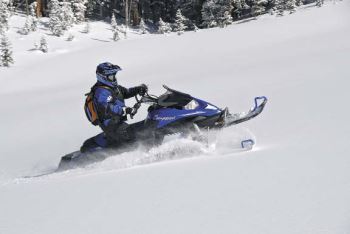 Let's describe the conditions in which the 700 RMK and Nytro MTX were tested the day we rode them. We started our ride out near Grand Lake, CO (elevation 8,400 feet), headed over Illinois Pass into the bowls and mountains that make up the headwaters of the Illinois River. It's about a 20-plus mile ride in one way over trails, on paths that somebody once thought were trails, through the trees, off-trail, over deep moguls-just about any kind of condition you could ask for in the mountains. The trail over Illinois Pass was whooped out and prime for suspension testing. Once to our destination, we climbed to elevations up to 11,480 feet, played in the powder, sidehilled, shot an insane amount of photos and generally worked hard. Oh yea, it was sunny all day, too. No doubt it was one of our best days of riding last winter.
Let's describe the conditions in which the 700 RMK and Nytro MTX were tested the day we rode them. We started our ride out near Grand Lake, CO (elevation 8,400 feet), headed over Illinois Pass into the bowls and mountains that make up the headwaters of the Illinois River. It's about a 20-plus mile ride in one way over trails, on paths that somebody once thought were trails, through the trees, off-trail, over deep moguls-just about any kind of condition you could ask for in the mountains. The trail over Illinois Pass was whooped out and prime for suspension testing. Once to our destination, we climbed to elevations up to 11,480 feet, played in the powder, sidehilled, shot an insane amount of photos and generally worked hard. Oh yea, it was sunny all day, too. No doubt it was one of our best days of riding last winter.
We were able to test those two machines on every conceivable snow surface except maybe extreme hard pack. In places, the powder was easily two to three feet deep.
If you're just riding smooth, well-groomed trails, most any suspension works well. We had some of those kinds of trails that day but we also covered beat-up backcountry forest service roads and goat trails through the trees. It was over Illinois Pass, though, that suspensions took a beating-along with the rider, depending on what machine he was one.
Those riding the Polaris 700 RMK sat on an RMK rear suspension with your basic but reliable Ryde FX (center) and Ryde AFX (rear) shocks. Rear travel is listed at 15.5 inches. On the front is the IQ RMK adjustable suspension, aging with Ryde FX shocks.
New Rear Suspension
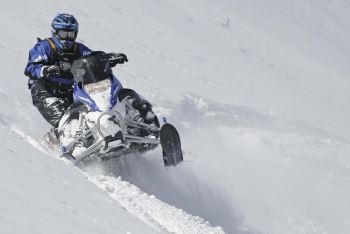 It's the rear suspension that boasts the new hardware on the Nytro MTX for 2009 with the new ProMountain CK 153 rear suspension, which features an aluminum SOQI HPG center shock and aluminum SOQI HPG rear piggyback shock with a compression adjustable clicker. The suspension still maintains the same geometry as years previous, including a 3.5-degree tip-up for better trail manners. Rear travel is 14 inches. On the front, the Nytro MTX uses an independent double wishbone design with 40 mm SOQI aluminum HPG shocks. Looking at the front shocks, you'll notice the tall shock towers, which Yamaha points out were designed that way to give the sled high ground clearance and long shock travel while still maintaining the machine's ability to corner flat, helping stability and rider confidence.
It's the rear suspension that boasts the new hardware on the Nytro MTX for 2009 with the new ProMountain CK 153 rear suspension, which features an aluminum SOQI HPG center shock and aluminum SOQI HPG rear piggyback shock with a compression adjustable clicker. The suspension still maintains the same geometry as years previous, including a 3.5-degree tip-up for better trail manners. Rear travel is 14 inches. On the front, the Nytro MTX uses an independent double wishbone design with 40 mm SOQI aluminum HPG shocks. Looking at the front shocks, you'll notice the tall shock towers, which Yamaha points out were designed that way to give the sled high ground clearance and long shock travel while still maintaining the machine's ability to corner flat, helping stability and rider confidence.
In the small chatter bumps the SnoWest SnowTest staff gave both sleds high marks. One rider said of the Yamaha, "It does very well. The weight and suspension keeps the sled glued to the ground." Another said this about the Polaris, "What bumps?"
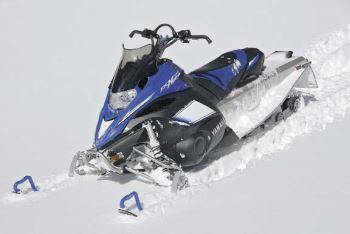 Half the crew at SnoWest gave the Polaris 700 RMK the edge in how it handled the big bumps while the other half gave the nod to the Nytro MTX. One of those leaning toward the Yamaha said, "The torque of the four-stroke along with the rider position and controls work with the suspension to let you double moguls easier than the RMK." Another SnowTest rider pointed out, "The suspension package has been refined and that improved the overall performance, but it still suffers in the big whoops due mostly to the extra weight, mostly in the nose."
Half the crew at SnoWest gave the Polaris 700 RMK the edge in how it handled the big bumps while the other half gave the nod to the Nytro MTX. One of those leaning toward the Yamaha said, "The torque of the four-stroke along with the rider position and controls work with the suspension to let you double moguls easier than the RMK." Another SnowTest rider pointed out, "The suspension package has been refined and that improved the overall performance, but it still suffers in the big whoops due mostly to the extra weight, mostly in the nose."
Another had this to say about the RMK, "It handles the big bumps very well. Polaris has done its homework on shock valving." Still another rider had praise for the Ryde shocks, "Pretty darn good in comparison to the Walker [Evans]."
When it came to crossing Illinois Pass, all the SnowTest riders wanted to be on either the 700 RMK or the Nytro MTX.
Separating The Machines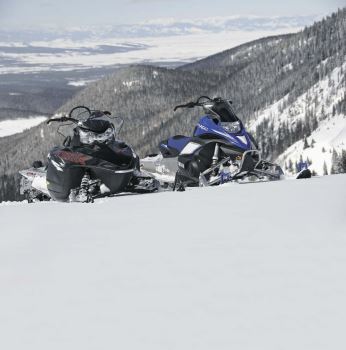
It was in the deep powder that the two machines became separated, literally and figuratively. The Yamaha Nytro MTX just couldn't negotiate with deep powder as well as the RMK, which is 66 lbs. lighter.
Here are some comments about how each sled handled the deep powder we experienced that day.
Polaris RMK
- "Excellent pow sled. By far the class leader. Very predictable and confidence inspiring."
- "Very easy to sidehill. The 155 does its job in the powder."
- "Awesome in the powder. Does what you ask it to."
Yamaha Nytro MTX
- "Does good considering it's a four-stroke, but not great compared to the RMK."
- "Sidehills okay for a heavier sled but just too heavy to float very well."
- "If snow is deep enough it does better. It's fun to sidehill when the snow is the right depth but not so much in harder snow or really deep snow. If you're on the throttle it does better in powder. At slower speeds it's not as good because the nose doesn't want to stay on top."
Other Areas
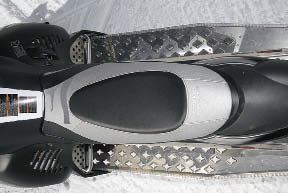 In many other areas of each snowmobile, such as the track (RMK 155, Nytro MTX 153), seat, handlebar and gauges, we felt things were fairly comparable. We felt the RMK skis were better all around (hard pack, deep powder, trails), as well as the running boards (Nytro MTX boards allow too much snow buildup and don't have near enough traction).
In many other areas of each snowmobile, such as the track (RMK 155, Nytro MTX 153), seat, handlebar and gauges, we felt things were fairly comparable. We felt the RMK skis were better all around (hard pack, deep powder, trails), as well as the running boards (Nytro MTX boards allow too much snow buildup and don't have near enough traction).
There is one more glaring difference between the two mountain machines-the MSRP. If you're basing your buying decision on price as much as anything else, then the 700 RMK will catch your eye at $9,399. That's compared to the price tag of the Nytro MTX, which is $10,799, a $1,400 difference.
But in the end, even taking away the fact that it gives up 10 hp, the Nytro weighs more and that gives the edge to the 700 RMK, especially in the conditions we rode and tested in, which, quite honestly, are the kind of conditions we would ride in all the time if we got to choose.
Having said that, we are encouraged with what Yamaha is doing with the mountain Nytro. The Nytro MTX is 55 lbs. lighter than the Apex MTX, a significant number. And if you're looking to pump up the horsepower with a supercharger, it's tough to beat the Nytro MTX. That combination can spank a mountain because it greatly improves the power-to-weight ratio. There are far more reasons to buy a Nytro MTX than not.
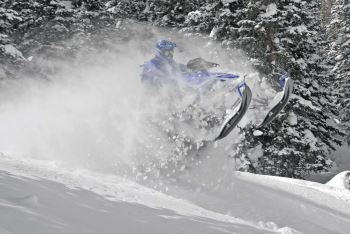 With all the well-deserved hype the 800 class gets and the economics of buying a 600, the question begs, why buy a 700? Some will say it's easier to justify purchasing a Yamaha Nytro MTX because of its four-stroke technology and that alone sets it apart from other sleds, trail or mountain. And it settles in nicely between other mountain sleds Yamaha offers-the Apex MTX (150 hp) and Phazer MTX (80 hp). The Nytro MTX is not a bad choice at all.
With all the well-deserved hype the 800 class gets and the economics of buying a 600, the question begs, why buy a 700? Some will say it's easier to justify purchasing a Yamaha Nytro MTX because of its four-stroke technology and that alone sets it apart from other sleds, trail or mountain. And it settles in nicely between other mountain sleds Yamaha offers-the Apex MTX (150 hp) and Phazer MTX (80 hp). The Nytro MTX is not a bad choice at all.
Nor is the 700 RMK. Strip away all the numbers like horsepower and weight and track length and all those things that define a mountain snowmobile on paper and go with your gut feeling. The 700 RMK feels right on the snow.
In our mind, the question isn't, Why buy a 700? The question is, Why not buy a 700?
| General | Polaris 700 RMK | Yamaha Nytro MTX |
|---|
| Age of this model |
Third year |
Second year |
| Powerplant/Powertrain |
| Engine |
Liberty |
Yamaha |
| Displacement |
700cc |
1049cc |
| Cylinders |
2 |
3 |
| Carburetion |
Cleanfire Injection (4) |
41 mm Mikuni fuel injection |
| Primary clutch |
P-85 |
YVXC |
| Secondary clutch |
P2 |
YVXC |
| Drive sprocket |
8-tooth drive |
7-tooth drive |
| Chassis/Suspension |
| Chassis |
IQ |
FX |
| Front suspension |
IQ RMK Adjustable |
Independent, double wishbone |
| Front shocks |
Ryde FX |
40 mm SOQI aluminum HPG |
| Front travel |
9 inches |
7.3 inches |
| Rear suspension |
RMK |
ProMountain CK 153 |
| Rear shock |
Ryde AFX |
SOQI |
| Rear travel |
15.5 inches |
14 inches |
| Center shock |
Ryde FX |
SOQI aluminum HPG w/piggyback clicker |
| Ski |
Gripper |
Wide saddleless plastic mountain ski |
| Dimensions/Capacities |
| Dry weight |
487 lbs. |
553 lbs. |
| Track |
Series 5.1 15x155x2.4 |
Camoplast Maverick 15x153x2.25 |
| Ski stance |
39-41 inches |
38.6 |
| Fuel |
11.5 gallons |
7.4 gallons |
| Price |
$9,399 |
$10,799 |